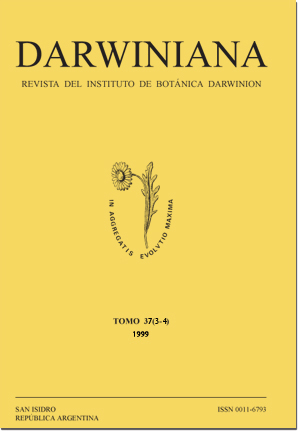Seedling anatomy of three species of Cupressus (Cupressaceae)
DOI:
https://doi.org/10.14522/darwiniana.2014.373-4.351Keywords:
Seedling, Transition zone, Anatomy, Cultivated trees, CupressusAbstract
Structural anatomy of seedlings of Cupressus lusitanica Mill., C. macrocarpa Hartw. and C. sempervirens L. (Cypress) cultivated in Argentina was studied. Seedlings of these species were fixed at eigth different stages of the germination process. Anatomical features of root, hypocotyl, cotyledonary node, cotyledons and epicotyl were described. The root-hypocotyl-cotyledon vascular transition was analized. In the root and in most of the hypocotyl length, the protoxylem exhibits exarch position. At the cotyledonary node the metaxylem differentiates gradual- and laterally divergent from the protoxylem. In sections of the upper zone of the hypocotyl, close to the cotyledonary node, the protoxylem shows an endarch position. In the epicotyl, the undifferentiated procambium alternates with the cotyledonary vascular bundles. The number of xylematic poles is equal to the number of cotyledons in thr three species.Downloads
Published
31-12-2011
How to Cite
De Magistris, A. A., & Castro, M. A. (2011). Seedling anatomy of three species of Cupressus (Cupressaceae). Darwiniana, Nueva Serie, 37(3-4), 199–207. https://doi.org/10.14522/darwiniana.2014.373-4.351
Issue
Section
Anatomy and Morphology
License

Starting on 2012, Darwiniana Nueva Serie uses Licencia Creative Commons Atribución-NoComercial 2.5 Argentina .






